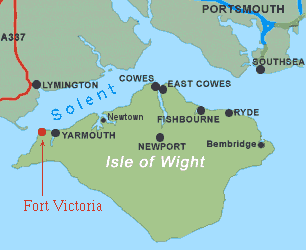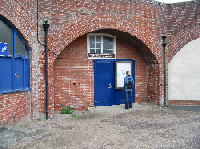FORT VICTORIA
A Brief History
King Henry Vlll feared invasion from France and Spain and built several forts along the south coast to command harbours and landing zones. He built Yarmouth Castle, Hurst Castle and Sharpnode Blockhouse, the first defensive position on this site, built in 1547.
By 1559 Sharpnode Blockhouse was starting to collapse. However, it wasn’t until 1588, with the threat of the Armada, that Sharpnode Blockhouse was rebuilt as Carey’s Sconce . It is thought that Carey’s Sconce had fallen into disrepair by the 1620’s.
The next time the site was chosen to be a defensive position was in 1804, when Napoleon threatened to invade Britain. Sconce Point Battery , acting in conjunction with both Yarmouth and Hurst Castles would have defended the Needles Passage. When the war ended in 1815 the battery turned into a coastguard station.
 | Even though French military strength was greatly reduced, Britain was paranoid about invasion. Queen Victoria demanded action be taken to prepare our coastal defences. If an enemy were to force the Needles Passage he could not only attack Portsmouth (then our main fleet base) via its ‘back door’, but also raid the great commercial port of Southampton. Fort Victoria was built in 1855, and Fort Albert (further along the coast) in 1856. |
Fort Victoria was built within 18 months, partly because the 350 workmen were allowed to stay on H.M.S. Talbot, moored near the site, by the Admiralty.
Although Fort Victoria was really too low-lying for comfort, the battle between fort and ship would generally be won by fort:-
- ships pitched and rolled continuously, whereas forts provided a steady gun platform;
- each naval gun captain had to find the range of the target, whereas land gunners frequently had their pieces laid on the likely approaches and knew the range from long practice;
- any ship made of wood could be set alight by heated shot, whilst the forts were protected by masonry and brickwork;
- by sighting on the masts of hostile warships the fort could hit their hulls even when a cloud of powder smoke obscured them and made it hard for naval gunners to return fire with any accuracy.
The fort is split into several casemates to prevent the destructive passage of round shot from the flank along the whole line of guns, while the brick vaulting would offer overhead protection against sea-borne mortars. To discourage enemy marines from attempting a boat attack, the seaward faces of the fort were defended by a deep, water filled ditch 20 feet wide and with stone sides. The top of the inner side was curved to prevent grappling hooks from lodging.
Fears of a lightning invasion by a French army rushed across the channel in steamships were illusory. Such laden troopships would be very vulnerable to the Royal Navy. The main role of the Needles and Spithead forts, therefore, would be to protect Portsmouth, the Navy’s main channel base, against raids by fast steam warships.
Fears of a lightning invasion by a French army rushed across the channel in steamships were illusory. Such laden troopships would be very vulnerable to the Royal Navy. The main role of the Needles and Spithead forts, therefore, would be to protect Portsmouth, the Navy’s main channel base, against raids by fast steam warships.
| Fort Victoria never had to resist enemy warships, but probably could have repelled them in the days before the introduction of ironclad battleships firing elongated, masonry shattering shells. It was the forts land defences that were poor, any flanking fire did not cover the landward corners of the barracks blocks. |  |
Main Armaments:-
- eleven 10 inch guns, firing spherical explosive shells;
- ten 68 pounder smooth bore guns firing solid shot;
- both guns had a maximum range of 2899m);
- six 32 pounder smooth bore guns installed on each barracks roof, all firing seawards over the casemated batteries
By 1858, with the introduction of rifled guns and armoured ships, Fort Victoria and Fort Albert were obsolete. By 1861 the fort was being regarded as a barracks and military storehouse.
In 1891 the Submarine Mining Company came to Fort Victoria to lay a coastal minefield. Two types of mines were available at the time, mechanical mines which were dangerous to friend and foe alike, and electrical mines which were controllable from the shore. At Fort Victoria electrical contact mines were used. Each was moored by chain to a heavy weight called a sinker, so as to float just below the surface. When a vessel struck a mine a signal would be sent to an operator who would either detonate the mine, or in the case of friendly contact, cancel the detonation.
During a freak snowstorm on April 25th 1908, the cruiser H.M.S. Gladiator was rammed off Fort Victoria by the American liner St. Paul. Twenty-seven men from H.M.S. Gladiator died, but many more would have perished without the intervention of men from Fort Victoria. H.M.S. Gladiator became a tourist attraction, before being towed to Amsterdam and scrapped.
In 1891 the Submarine Mining Company came to Fort Victoria to lay a coastal minefield. Two types of mines were available at the time, mechanical mines which were dangerous to friend and foe alike, and electrical mines which were controllable from the shore. At Fort Victoria electrical contact mines were used. Each was moored by chain to a heavy weight called a sinker, so as to float just below the surface. When a vessel struck a mine a signal would be sent to an operator who would either detonate the mine, or in the case of friendly contact, cancel the detonation.
During a freak snowstorm on April 25th 1908, the cruiser H.M.S. Gladiator was rammed off Fort Victoria by the American liner St. Paul. Twenty-seven men from H.M.S. Gladiator died, but many more would have perished without the intervention of men from Fort Victoria. H.M.S. Gladiator became a tourist attraction, before being towed to Amsterdam and scrapped.
 | During the two World Wars the fort was used for various purposes, mainly as a landing point and for storage. Fixed torpedo tubes were also fitted to Fort Victoria pier. It was used as a training base several times during its existence. In 1962 the fort lost its status as a military garrison. |
Page last updated on: 04/12/2003





